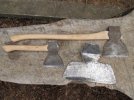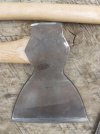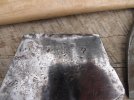-
The BladeForums.com 2024 Traditional Knife is available! Price is $250 ea (shipped within CONUS).
Order here: https://www.bladeforums.com/help/2024-traditional/
You are using an out of date browser. It may not display this or other websites correctly.
You should upgrade or use an alternative browser.
You should upgrade or use an alternative browser.
Broad Axes...post 'em up.
- Thread starter M3mphis
- Start date
I'm in the same boat. Just a couple of broad hatchets. Looking hard for a broad axe to slip by the bidders on ebay. Rough hewing beams would be a fun way to earn a little extra cash..
there was a nice one on the bay the other day.
nobody bid on it. i think it was at a starting bid of $24.99 not five bucks but not bad for a antique tool of quality
i'm getting ready to hang one for a friend. no makers mark. appears to have been used little, which seems typical.
buzz
- Joined
- Sep 24, 2010
- Messages
- 2,395
Here is one :


Square_peg
Gold Member
- Joined
- Feb 1, 2012
- Messages
- 13,850
Nice!


- Joined
- Sep 24, 2010
- Messages
- 2,395
- Joined
- Jan 13, 2011
- Messages
- 2,562
you are correct sir
That's not the weight is it?
- Joined
- Sep 24, 2010
- Messages
- 2,395
That's not the weight is it?
Indeed it is.
- Joined
- Sep 24, 2010
- Messages
- 2,395
Here are some more, per request of Memphis : Sorry, forgot I had these. I am not into broad axes.
Amoskeag and AG Peck - both older than sin

Fayette R Plumb with Anchor logo, and a crisp never used Keen Kutter

Collins & Co Legitimus used by the phone company, and a linemans Bell system beast :

Couple True Temper railroad examples :

Nice trio of C Hammond - 1, 4, 2 - Still looking for a 3.

Beatty and Son

D Simmons and Co - Cohoes Ny - old - out of business in 1860

Davis and Co - cant find info - only as a metal worker - mid 1800s. Has some age and wear...

Amoskeag and AG Peck - both older than sin

Fayette R Plumb with Anchor logo, and a crisp never used Keen Kutter

Collins & Co Legitimus used by the phone company, and a linemans Bell system beast :

Couple True Temper railroad examples :

Nice trio of C Hammond - 1, 4, 2 - Still looking for a 3.

Beatty and Son

D Simmons and Co - Cohoes Ny - old - out of business in 1860

Davis and Co - cant find info - only as a metal worker - mid 1800s. Has some age and wear...

- Joined
- Sep 12, 2009
- Messages
- 1,946
operator..."IM NOT INTO BROAD AXES ALL THAT MUCH"...
yeah right
those all look really nice... maybe i should get one...
yeah right
those all look really nice... maybe i should get one...
- Joined
- Jan 13, 2011
- Messages
- 2,562
trailmaker has a big, bad one, see it here: http://www.bladeforums.com/forums/showthread.php/918098-Heavy-Metal
Have you hung that beast yet????
Have you hung that beast yet????
- Joined
- May 15, 2011
- Messages
- 506
trailmaker has a big, bad one, see it here: http://www.bladeforums.com/forums/showthread.php/918098-Heavy-Metal
Have you hung that beast yet????
So far I've only managed to work on the handle a bit. It's been hard to find the time lately but hopefully I'll get to it soon. To answer your other question about my axe count; I think it's around seventy five so far. I've got some more broad axes to add to this thread, hopefully later tonight.
- Joined
- May 15, 2011
- Messages
- 506
Here is one :

Wow that's a beauty. Is that a convex edge? Single or double bevel?
- Joined
- May 15, 2011
- Messages
- 506
Some Euro broad axes.














Square_peg
Gold Member
- Joined
- Feb 1, 2012
- Messages
- 13,850
Some Euro broad axes.
Very cool. What was the science behind that shape? Does anyone know? I can imagine an advantage and a disadvantage. A possible disadvantage would be that while cutting at the lower edge of the blade the force applied to the handle is further off center from the eye, possible putting more torque on the handle and wearing it more quickly. OTOH, the initial contact with the wood would be more directly centered on the eye, possibly absorbing the impact better and then having only a lesser cutting force (no impact) applied during the remainder of the cut. Does that make sense?
- Joined
- Mar 12, 2011
- Messages
- 214
Small potatoes in comparison to a lot of you guys but here's a couple photos of my broads:
Welland Vale Hatchet on left, Marshall Wells Zenith broadaxe, and a 5 pound Collins Red Seal.

I've really grown fond of Welland Vale; this little thing is one of only a couple axes I've found that have a real lasting ring to them when you flick them with your finger.
Logo here sort of reminds me of my VW too

This 7 pound axe hasn't ever been sharpened; has a pretty nice factory edge with a little use, mostly as a hammer. Seems like it sat in some barn for a long time, some pitting on the backside but it's still pretty nice.

Welland Vale Hatchet on left, Marshall Wells Zenith broadaxe, and a 5 pound Collins Red Seal.

I've really grown fond of Welland Vale; this little thing is one of only a couple axes I've found that have a real lasting ring to them when you flick them with your finger.
Logo here sort of reminds me of my VW too

This 7 pound axe hasn't ever been sharpened; has a pretty nice factory edge with a little use, mostly as a hammer. Seems like it sat in some barn for a long time, some pitting on the backside but it's still pretty nice.

- Joined
- May 15, 2011
- Messages
- 506
Very cool. What was the science behind that shape? Does anyone know? I can imagine an advantage and a disadvantage. A possible disadvantage would be that while cutting at the lower edge of the blade the force applied to the handle is further off center from the eye, possible putting more torque on the handle and wearing it more quickly. OTOH, the initial contact with the wood would be more directly centered on the eye, possibly absorbing the impact better and then having only a lesser cutting force (no impact) applied during the remainder of the cut. Does that make sense?
I'm not sure why that pattern evolved, it does seem like it would be less secure than other eye shapes. Maybe it was to save weight, or maybe it was just easier to forge than other types of eyes. Re-hafting these axes was probably pretty easy compared to some of the "goosewing" patterns that have a long socket with a reverse taper.
- Joined
- Sep 24, 2010
- Messages
- 2,395
Trailmaker I suggest you back off the whole axe collection deal. It isnt good for you.


